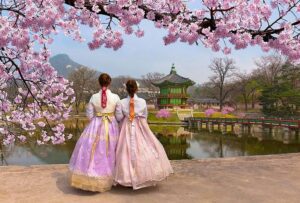The History of South Korea
Introduction:
South Korea, officially known as the Republic of Korea, boasts a rich and complex history that has shaped its modern identity. From ancient kingdoms to a modern economic powerhouse, South Korea’s journey has been marked by periods of tumultuous change, resilience, and remarkable development.

Prehistoric Era:
The Korean Peninsula has hosted human inhabitants for thousands of years, with evidence of human presence dating back to the Paleolithic Age. Early Korean societies practiced agriculture, forming communities around fertile river valleys and coastal plains. Consequently, these early inhabitants developed unique pottery styles and burial customs, laying the foundation for Korean culture.
Ancient Korea:
South Korea’s history dates back to ancient times, with evidence of human habitation dating back to the Lower Paleolithic period. Various tribes and kingdoms inhabited the Korean Peninsula, with the Gojoseon being one of the earliest recorded states. According to legend, Dangun, the legendary founder of Korea, founded the state of Gojoseon in 2333 BCE. However, much of what we know about this period comes from mythological texts, and historical records become clearer with the emergence of the Three Kingdoms period.
Three Kingdoms Period (57 BCE – 668 CE):
The Three Kingdoms period was characterized by the presence of three main rival kingdoms: Goguryeo, Baekje, and Silla. Each kingdom vied for control over the Korean Peninsula, leading to a series of wars and alliances. Goguryeo, located in the northern part of the peninsula, was known for its military prowess. Baekje, situated in the southwest, had strong cultural and economic ties with China and Japan. Silla, in the southeast, eventually emerged as the dominant power through alliances and conquests.
Unified Silla and Later Three Kingdoms:
Silla eventually unified the Korean Peninsula under its rule in 676 CE, marking the beginning of the Unified Silla period. This era saw significant advancements in culture, arts, and Buddhism. However, internal strife and external threats led to the decline of Silla’s power. In 918 CE, the kingdom of Goryeo emerged and replaced Silla as the ruling dynasty. Goryeo maintained control over Korea for nearly 500 years, adopting Confucianism as the state ideology and developing a strong bureaucracy.
Joseon Dynasty (1392 – 1910):
The Joseon Dynasty was founded by General Yi Seong-gye in 1392 after overthrowing the Goryeo Dynasty. The early years of the Joseon Dynasty were marked by Confucian reforms and cultural flourishing, including the creation of the Korean alphabet, Hangul, by King Sejong the Great in the 15th century. However, the latter part of the dynasty was characterized by internal corruption, factionalism, and external invasions, particularly by the Japanese in the late 16th century.
Japanese Occupation (1910 – 1945):
In 1910, Korea was annexed by Japan after the signing of the Japan-Korea Annexation Treaty, effectively ending the Joseon Dynasty. The Japanese colonial rule brought about significant changes to Korean society, including the suppression of Korean culture and language, forced labor, and military conscription. Korean resistance movements emerged, but they faced harsh repression from the Japanese authorities.
Division and Korean War (1945 – 1953):
At the end of World War II in 1945, Korea was liberated from Japanese rule, but the country was divided along the 38th parallel into Soviet and American zones of influence. This division laid the groundwork for the Korean War, which began in 1950 when North Korean forces invaded South Korea. The
Unified Silla and Goryeo Dynasty:
In the late 7th century, the Silla kingdom unified the Korean Peninsula under its rule, ushering in a period of stability known as the Unified Silla Period (668–935). During this time, Buddhism flourished, and Silla established diplomatic relations with China and Japan. Subsequently, the Goryeo Dynasty (918–1392) continued Silla’s legacy, further developing Korean culture, art, and governance.
Joseon Dynasty:
The Joseon Dynasty (1392–1897) stands as one of the longest-lasting dynasties in Korean history, known for its Confucian ideals, centralized bureaucracy, and cultural achievements. Under Joseon rule, Korea experienced significant advancements in literature, science, and technology. Despite this, the dynasty also faced external threats, including invasions by Japanese and Manchu forces.
Japanese Colonial Rule:
In 1910, Japan colonized Korea following the signing of the Japan-Korea Annexation Treaty. Consequently, this period witnessed cultural suppression, forced labor, and exploitation of resources by Japanese authorities. Despite resistance, the Korean people endured hardship, laying the groundwork for the independence movement that followed.
Division and Korean War:
After World War II, Korea divided along the 38th parallel into two separate zones of occupation, with the Soviet Union controlling the north and the United States controlling the south. In 1950, the Korean War erupted when North Korean forces invaded South Korea. The war lasted three years and ended in a stalemate, with the signing of an armistice agreement in 1953.
Cultural Heritage Preservation:
Despite its rapid modernization, South Korea remains deeply rooted in its cultural heritage. Efforts to preserve and promote traditional Korean culture are evident in initiatives such as the restoration of historical sites, the promotion of traditional arts and crafts, and the designation of UNESCO World Heritage sites like the Jongmyo Shrine and the Changdeokgung Palace Complex. These efforts not only contribute to national identity but also attract tourists from around the world, boosting the country’s tourism industry.
Global Diplomacy and Soft Power:
South Korea has increasingly leveraged its soft power to enhance its global influence and diplomatic relations. Cultural exports, such as K-pop music, Korean dramas (known as K-dramas), and Korean cuisine, have gained immense popularity worldwide, contributing to the phenomenon known as the “Korean Wave” or “Hallyu.” The government has actively supported the promotion of Korean culture abroad through initiatives like the Korean Culture and Information Service (KOCIS) and the Korean Cultural Centers located in various countries. Additionally, South Korea has played a significant role in international forums and organizations, advocating for issues such as human rights, environmental sustainability, and peace.
Technological Advancements and Innovation:
South Korea’s commitment to technological advancement has propelled it to the forefront of global innovation. The country earns renown for its cutting-edge technology companies, including Samsung, LG, and SK Group, which have significantly contributed to sectors such as electronics, telecommunications, and renewable energy. South Korea leads the world in internet connectivity and broadband penetration, boasting one of the fastest and most extensive networks globally. The government has also heavily invested in research and development, fostering a culture of innovation and entrepreneurship.
Environmental Sustainability and Green Initiatives:
In recent years, South Korea has placed increasing emphasis on environmental sustainability and green initiatives. Recognizing the importance of combating climate change and reducing carbon emissions, the government has implemented policies to promote renewable energy sources, such as solar and wind power. South Korea has also committed to reducing its reliance on fossil fuels and transitioning towards a low-carbon economy. Initiatives like the Green New Deal aim to create green jobs, improve energy efficiency, and foster sustainable growth while addressing environmental challenges.
Challenges of Urbanization and Infrastructure Development:
Rapid urbanization and industrialization have posed significant challenges to South Korea’s infrastructure and urban development. Cities like Seoul, Busan, and Incheon have experienced exponential growth, leading to issues such as traffic congestion, air pollution, and housing shortages. The government has responded by investing in infrastructure projects, expanding public transportation networks, and implementing urban planning initiatives to create more sustainable and livable cities. Efforts to revitalize urban areas and improve quality of life for residents are ongoing priorities.
Social Welfare and Healthcare:
South Korea has made strides in providing social welfare and healthcare services to its citizens. The country has a universal healthcare system that provides affordable medical care to all residents, contributing to high life expectancy and low infant mortality rates. However, challenges such as an aging population and rising healthcare costs necessitate ongoing reforms and investments in healthcare infrastructure and services. The government has also expanded social welfare programs to support vulnerable populations, including the elderly, disabled, and low-income individuals.
Education System and Academic Excellence:
South Korea emphasizes education and academic achievement strongly, and the world highly regards its education system. The country consistently ranks among the top performers in international assessments of student achievement, particularly in subjects like mathematics and science. South Korea’s rigorous education system fosters a highly skilled workforce and drives economic growth, characterized by long school hours and intense competition. However, concerns about excessive academic pressure and the well-being of students have led to calls for reforms to promote a more balanced approach to education.
Cultural Diversity and Immigration:
South Korea is becoming increasingly diverse due to immigration and globalization. While historically homogeneous, the country has seen a rise in the number of foreign residents and multicultural families in recent years. This demographic shift has led to greater cultural exchange and diversity in South Korean society, as well as challenges related to integration and social cohesion. The government has implemented policies to support multiculturalism and immigrant communities, including Korean language education programs and initiatives to combat discrimination and promote social inclusion.
Regional Cooperation and Global Partnerships:
South Korea actively engages in regional cooperation and global partnerships to address common challenges and promote peace and prosperity. As a member of organizations such as the United Nations, ASEAN, and the G20, South Korea contributes to global efforts in areas such as peacekeeping, development assistance, and economic cooperation. The country also maintains close ties with its neighbors in East Asia, including China, Japan, and Russia, despite historical tensions and territorial disputes. Through diplomacy and dialogue, South Korea seeks to foster stability and cooperation in the region.
Modernization and Economic Miracle:
Following the Korean War, South Korea embarked on rapid industrialization and economic development. Through government-led initiatives, investment in education, and promotion of export-oriented industries, South Korea achieved remarkable growth, transforming itself into one of the world’s leading economies within a few decades.

Democratization and Global Influence:
In the late 20th century, South Korea underwent democratization, transitioning from authoritarian rule to a vibrant democracy. Consequently, the country’s cultural influence expanded globally, with the rise of K-pop, Korean cinema, and technology giants like Samsung and LG making waves on the international stage.

Conclusion:
From its ancient origins to its modern-day prominence, South Korea’s history showcases the resilience and determination of its people. Despite facing numerous challenges throughout its history, South Korea has emerged as a dynamic and prosperous nation, poised to shape the future of the Korean Peninsula and beyond.
The History of South Korea…


Pingback: The Rise of BTS - MAVROH